Welcome to the 537 newly Not Boring people who have joined us since last Monday! If you aren’t subscribed, join 42,205 smart, curious folks by subscribing here:
🎧 To get this essay straight in your ears: listen on Spotify or Apple Podcasts
Hi friends 👋 ,
Happy Monday! This is a big one for me: Not Boring’s first birthday.
Instead of writing about a very big company, which I normally do on Monday, I’m writing about a very small one: Not Boring. It’s been a crazy year, I’ve learned a ton, and it’s just going to get better from here. But it was not at all obvious that this was going to work out a year ago.
Before we get to it, I just want to say a big thank you. Nothing in this story would have happened without you reading, commenting, conversing, and sharing. I feel very lucky that you’re willing to take time out of your day to read what I write.
If you want to bring some smart, curious friends along for year two:
Today's Not Boring is brought to you a Not Boring Day One-er
Fun Fact: Public was the first company ever to sponsor multiple Not Boring newsletters. They sponsored Knock Knock. Who's There? Opendoor. and have been with us ever since.
Public and Not Boring are a perfect match: like Not Boring, Public makes the investing conversation fun. Public is an investing app AND a social network for talking about business trends, and the social features make it easy to share ideas.
Thank Public for making Not Boring possible by hitting the link below and joining me over there. If you want to transfer your account from somewhere else, they’ll even cover the fees.
*Valid for U.S. residents 18+ and subject to account approval. Transfer fees covered for portfolios valued at or over $150. See Public.com/disclosures/.
A Not Boring Adventure, One Year In
This has been the wildest and most rewarding year of my life, both personally and professionally: our son, Dev, turned 6 months old yesterday, and Not Boring turned one on Friday.
A year ago, we knew that Dev was coming, but I had no idea what I was going to do. I had quit my job, launched an in-person company that got crushed by lockdowns (and was probably a bad idea anyway), and to top it off, I caught COVID the week I decided to start writing Not Boring. I was lost.
Somehow, since then, with all of your help, I’ve built my dream job. Over the past 365 days, I’ve:
Written and sent 417k words. That’s more than all seven Chronicles of Narnia.
Grown from under 500 subscribers to over 42,000.
Run a syndicate which has invested nearly $2 million in fourteen companies.
Generated more revenue than I’ve ever made in a full-time job.
I legitimately didn’t believe this was possible. I would see people with big followings on Twitter or big subscriber lists and think that they had some special je ne sais quoi. I still think that it could end at any moment.
Today, I want to share the Not Boring story as honestly as possible -- it often looks way easier from the outside -- with lessons I’ve learned on writing, growth, business models, investing, and creator psychology sprinkled in. We’ll cover:
Getting Here: Per My Last Email → Not Boring Club → Not Boring
Growth: Luck, Shares, Ups, Downs and Tommy
The Writing Process and Psychology
Business Model: Optimize for Growth and Opportunity
The Not Boring Syndicate
The Present and Future of Not Boring
If anything in this story seems planned, premeditated, or in any way clean, that’s just my brain going back, filling in gaps, and connecting dots. As much as I write about strategy, this story is about working hard even when it seems silly and following serendipity.
My biggest lesson so far: this is neither as impossible nor easy as it looks.
The Winding and Uncertain Road to Not Boring
Per My Last Email
I’m cheating a little when I say that it’s Not Boring’s one year birthday. I wrote a different newsletter -- Per My Last Email -- for almost a year before.
In early 2019, the board at Breather, where I worked, had just brought in a new CEO, who himself was in the middle of bringing in a new, experienced executive team.
A couple weeks into the new regime, Ben Rollert (then VP, Product at Breather, now CEO at Composer) and I presented at an exec team offsite about the need to differentiate and dig moats in an increasingly crowded and bubbly flex office market. We got cut off halfway through with something to the effect of: “Moats? This is a big market, we don’t need to worry about moats. We have a brand. That’s what Apple has.”
I realized that my brain was going to shrivel up and rot if I didn’t do something. Ben’s always been smarter than me. He saw the writing on the wall and quit. I couldn’t quit right then -- I managed a 150 person team and didn’t want to abandon them -- so instead, I used my annual learning & development budget to take David Perell’s Write of Passage course.
That was one of the best decisions I’ve ever made. One of the assignments for the course was to launch a Substack and get twenty people to subscribe. I reserved packym.substack.com, named it Per My Last Email, and begged my few hundred Twitter followers to sign up:

Two days later, I had 28 subscribers, and we were off to the races. I wrote Per My Last Email on the side, spending a few hours each weekend or early in the morning curating links to essays, books, podcasts, and videos with a dash of commentary. It grew to about 400 subscribers in eleven months. It didn’t make a dollar and I didn’t expect that it ever would.
But I had always told Puja and my family that if I ever got really rich and retired early, all I’d want to do is read and write and talk to really smart people. Per My Last Email let me start doing that in a small way. As someone who’d been so singularly focused on work for a decade, it felt good to have a hobby.
Lesson: Make room for hobbies, even just a few hours a week.
Not Boring Club
Writing was also a way for me to test out a startup idea I had in a really lightweight way.
The idea was Not Boring Club: a mashup of social club and continuing education, Soho House meets college extracurriculars for busy grownups.
I wrote about education and IRL Member Communities to make sure there was a real opportunity. One of the problems with being good at writing is that you can convince people that bad ideas are good. You can even convince yourself.
In October 2019, I quit Breather to start it. I wrote business plans, memos, started a debate club, made decks, built a website, and tried to write my way into a business model. I couldn’t quite figure it out. I knew what I wanted to exist, but the business model wasn’t clicking. The people around me -- my sister, Puja, even my mom -- tried to gently tell me that this wasn’t it. They were, in hindsight and in the back of my mind even then, so obviously right.
But I persisted, and announced the launch in a blog post. Thankfully, I didn’t raise money or sign a lease. Instead, I decided to start experimenting with a Slack group and a series of in-person events. By February, I started onboarding the first 150 (free) members with a series of small group dinners. On March 10th, we had to “postpone” a welcome dinner. Then a Debate Club. Then the next dinner. Then the next dinner.
We quickly moved Not Boring Club online with cocktail making classes, lightning presentations, book clubs, and trivia nights. One day, I was frantically making slides for that night’s Trivia Night. Puja kind of gave me a look, and I realized how fucking ridiculous it seemed. How fucking ridiculous it was. That night, eight people showed up to play trivia.
That was the final straw. I needed to do something different, but I couldn’t figure out what. One thing I knew for sure: I was a terrible online community leader, and I kind of hated it. If I’m being honest, COVID was a good excuse to erase my mistake. The Not Boring Club went on the back burner.
Lesson: Don’t be afraid to admit that something you thought was a good idea turned out to be a bad idea. You’ll know it in your gut. Trust that instinct and cut bait.
Not Boring Newsletter
One year ago, I was locked in my Brooklyn apartment with COVID, feeling incredibly stuck and a little hopeless. Not Boring Club was on indefinite pause. In February, Puja and I found out we were having a baby, and I had zero income. The pressure was on.
My brilliant plan? To turn the newsletter into something that could at least pay rent at some point in the future while I tried to figure out what I wanted to do next. Maybe it would even help me find a new job.
At the time, I had weekly coaching calls with my mom. (Yup, you read that right.) On one of those calls, when I told her that the newsletter was the thing I was enjoying most and that I wanted to give it a shot, she said, “Why don’t you change the name of the newsletter to Not Boring?”
So I did, and announced the change in the Last Per My Last Email in late March 2020. When I sent that email, there were 473 people subscribed to Per My Last Email. I got aggressive and changed my goal from “1,000 subscribers by the end of the year” to “1,000 subscribers by the end of April.” (At the time, I thought “end of April” was synonymous with “end of quarantine.”)
After I announced the name change, I got a few replies saying, “Oh man, I loved Per My Last Email.” I called my mom and said that I thought I’d made a terrible mistake, that I’d messed up the newsletter too. Things were dark. But then they started to look up.
The biggest change from Per My Last Email to Not Boring, other than the name, was that instead of curating links, I started writing long (ok, very long) essays myself.
When I started writing, I wanted to write about tech and strategy (one of the first pieces I wrote was on Natively Integrated Companies and another was on Shen Yun and Startup Economics), but I thought the space was too crowded (the first piece I ever wrote was the Best of Ben Thompson).
With Not Boring, I went back to the things I wanted to write about all along, the things that I cared about and spent my free time reading and talking about anyway. It got really fun, really quickly. I wrote about Jeff Bezos’ Fashion Flex, then I wrote about Creative Destruction through the lens of the Mickey Mouse Club, then Supply Gluts and Hey Arnold. I realized that I could write about the things that I liked writing about -- strategy, finance, economics, and tech -- even though they were crowded, as long as I wrote about it with my own, unique voice.
That was a huge unlock, and a lesson in counter-positioning. Counter-positioning, my favorite of Hamilton Helmer’s 7 Powers, is when, “A newcomer adopts a new, superior business model which the incumbent does not mimic due to anticipated damage to their existing business.”
Technically, combining strategy, finance, and pop culture isn’t a new business model, nor is it better, but it’s still a moat. Ben Thompson might be better, smarter, more experienced, and more popular, but can you imagine Ben Thompson explaining creative destruction with this image?
Now I wasn’t intentionally counter-positioning -- there wasn’t that much foresight -- I was just having fun. In hindsight, I realize that there aren’t a lot of serious analyses out there that don’t take themselves seriously, because when people do serious analysis, they put on their serious analysis pants. The pop culture thing was a lucky accident.
After that post last April, something started to click. People were sharing Not Boring. It got picked up by the Financial Times. Subscribers grew 53% in one month.
Not Boring was still tiny, but it was starting to find that elusive *product-market fit*. Plus, people were stuck at home and bored. It was time to start focusing on growth.
Lesson: Lean into the intersection of what you’re passionate about and what’s different about you.
Growth: Luck, Shares, Ups, Downs, and Tommy
In May 2020, one year into writing a newsletter, I wrote Looking Back, Forward, and Up to reflect on one year of writing and set goals for the future. My first goal was to hit 5,000 subscribers by the end of the summer, and then turn on paid subscriptions. From that piece:
Goal #1: Grow to 5,000 Subscribers by Labor Day and 10,000 by May 21, 2021
It took ten months to get to 500, but less than two to get from there to 1,294. I’ll be testing a bunch of tactics over the next few months to get to 5,000, but the most important will be continuing to improve the content and provide more value so that you want to share it with your smartest friends.
Last April, my brother Dan and I I retreated to the beach, shaved off our overgrown pandemic hair, and brainstormed. We decided the best path was to come up with a list of 100 growth ideas. We got to eleven, and did maybe three of them. I’m not a growth hack person.
The most important growth levers over the past year ended up being really simple: quality and consistency. Show up enough for good things to happen every once in a while.
From the 473 people that received the last Per My Last Email, we’re now at 42,205 a year later -- 8,803% growth 📈 . That growth didn’t happen in a straight line.

Not Boring has grown through a series of fortunate events, and a lot of help from friends and internet strangers. A few of the highlights:
Polina Sharing Per My Last Email in The Profile. In November 2019, Polina Marinova shared Per My Last Email in her excellent newsletter, The Profile, after I won a contest to receive a tote bag full of some of her favorite books. I picked up 49 subscribers in two days, and I thought that was the most incredible thing in the world. Thanks, Polina!
Asking People to Share and Launching Not Boring. While I wrote Per My Last Email, I was afraid to ask people to share -- it felt so self-promotional -- so I buried the ask at the bottom of emails. When I announced that I was switching to Not Boring and making it a thing, I asked people to share front and center.
People did, and over 100 new subscribers joined that week.
Tommy: Product Hunt and Referrals
In May, I linked up with my friend Tommy Gamba, who came up with a few big unlocks.
First and foremost, he said that we should set up a landing page for Not Boring so that we could launch on Product Hunt. He built a landing page using Usmo, I sent an email introducing the homepage to our 1,885 subscribers, and we launched on ProductHunt.
Because people read the email and went over to Product Hunt to upvote, we ended up as the #2 Product of the Day, and in the top 5 for the week. We more than doubled subscribers in two days, from 1,800 to 3,700. I remember having dinner with Puja in Athens, NY as the signups rolled in and realizing for the first time that this actually had potential to be my full-time thing. That wouldn’t have happened without Tommy -- thank you, Tommy!!
Tommy also launched a Referral Program through which many of you have invited over 2,000 people to join the Not Boring family -- thanks to all of you for telling your friends! Props to the top three referrers: Joakim Jardenberg, Hunter Walk, and Johannes Sundlo. NB 💙 🇸🇪 .
Writing Essays That People Share
After Product Hunt, Not Boring started to pick up momentum. The more people there are reading, the more people who might potentially share. This has been the biggest growth engine for Not Boring, and it’s been totally unpredictable. Some weeks, I write things that I think are great and no one shares them. Others, I’m embarrassed to hit send and they blow up.
A few of the most popular posts include:
Tencent: The Ultimate Outsider and Tencent’s Dreams (107,980 combined views) - I sat in the basement for hours and hours looking up Tencent’s investments, and when I asked Dan and Puja to edit the essay, I could tell they both hated it. They told me to break it into two posts, and they became two of the most popular I’ve written. But it didn’t happen on the first send; it took a thread blowing up to get most of the views.
Stripe: The Internet’s Most Undervalued Company (62,159 views) - This highlights an unintentional growth trick I’ve discovered: when you write about a company with passionate employee bases, they share.
APIs All the Way Down (108,421 views) - On Sunday afternoon, I told Puja the essay was terrible and I couldn’t send it. She said she actually loved it, so I sent. It quickly got great feedback and a bunch of shares, then Patrick O’Shaughnessy shared it essay and brought in a ton of subscribers.
Power to the Person (80,376 views) - Li Jin, who coined the phrase Passion Economy and whose work I cited throughout the piece, shared it. Her stamp of approval meant a lot.
Excel Never Dies (207,818 views) - I co-wrote this one with Ben Rollert, and we got to the top of Hacker News, linked in the New York Times twice (in Dealbook and Paul Krugman’s column) and The Browser, and the Excel twitter account even retweeted us.
That’s been the formula: write a bunch of essays, and sometimes, people will want to share the ones that resonate most with them.
Random Dumb Luck and Twitter
So much of Not Boring’s growth has come from dumb luck.
A bunch of people subscribed after this tweet about Amazon’s investor slides went viral.
Dan Teran included me in a list of newsletter writers he likes reading in May, and I remember watching my inbox that night and seeing names of people I couldn’t believe would ever read what I wrote.
Just yesterday, Web and Lenny including me in lists of writers they like brought in over 100 subscribers.
Hundreds of other examples, big and small.
I’m missing a ton of you, but every time I see anyone tweet about Not Boring, it means a lot. Shoutouts from people other people trust go 1000x further than me saying things about Not Boring ever could.
The past year has been a series of me turning to Puja in disbelief, saying, “Woah! Person X just tweeted about Not Boring. I love Person X. Holy shit.” Some of those people have become good friends. I hope that never stops feeling mind-blowingly cool.
There have been countless small examples of being in the right place at the right time, and often, that right place has been Twitter. I’ve made great friends there, and have gotten the chance to interact with so many of you. To join the conversation, follow me and say hi.
Not Boring’s subscriber growth looks almost like the hockey stick that startups dream of, but that masks a lot of the bumps. Every time I write something and it doesn’t do well, and every week subscriber growth slows, I feel like the whole thing might be coming to an end.
Lesson: Sustainable growth comes from a consistently quality product that people want to share. Growth hacking doesn’t work long-term, but it does help to kick things off.
Writing Process and Psychology
Even though Not Boring has grown so much faster than I expected it would, I can’t shake that feeling that each week is going to be the last, and that soon, you’re all going to wake up to the fact that I’m just some idiot in a basement writing about things I’m deeply underqualified to write about. A few weeks ago, I went on ConvertKit founder Nathan Barry’s podcast. A writer I really respect reached out after listening and wrote:
I'm listening to your podcast with Nathan Barry. The fear of the lack of interesting topics... I literally thought it was just me.
It’s not. I think it’s everyone.
The #1 question I get about Not Boring is what my writing process looks like: how do I choose what to write, research, and put out two essays per week.
Let’s take the last one first. I was a runner in high school. I didn’t look like a runner -- I was kinda fat -- but I was good. Steve Prefontaine was a hero, and this quote of his is one of my all-time favorites:
I’m writing this on Easter Sunday. I’ve been up since 7am after sleeping six restless, post-COVID-vaccine hours. I’m physically and mentally exhausted. But I’ve been at the computer for eight hours today. I was at the computer eight hours yesterday. I don’t think I’m smarter than anyone, but I do think I can outwork everyone. I haven’t taken a day off this year other than the two days I had COVID, the four days after Dev was born, and a week around Christmas, including weekends. Seven days a week, 352 of the past 365 days.
That’s not a brag. I wish I could take time off. It seemed particularly silly when I was making no money on this newsletter and had to turn down socially distanced hangs with friends or dinners with family to write it. I couldn’t be luckier that Puja was so understanding; I don’t know if I would have been. But I’m genuinely petrified that each week, if I don’t give it everything I have, could be the last week that Not Boring grows.
Even just taking those four days off for Dev’s birth, growth slowed from a consistent 1,000 new subscribers per week to 400-500 for the next few weeks. This is a momentum game as much as anything.
That’s what I mean when I say that doing this is neither as impossible or as easy as it seems from the outside. It’s taken a ton of hard work.
Part of the need for hard work comes from my lack of process. I have a running list of topics that I want to write about in Roam, and every week, when I look at it, I realize that I don’t want to write about anything on that list. Instead, I spend a lot of time on Twitter and talking to people to figure out the most interesting companies and things going on that people don’t quite understand, and then I try to understand and translate.
For a Monday piece, that typically means figuring out what I’m going to write about sometime on Thursday afternoon or Friday morning, and starting to research. For APIs All the Way Down, I knew that APIs were important, but I didn’t quite understand what made them special. Then Stripe and Shopify announced a deeper partnership and I wanted to figure out why. So to start, I did a couple things: called two people who could point me in the right direction, and then found every article and podcast I could and dove in. Here’s what my Roam looks like:
Each gray dot has rows and rows of notes collapsed under them. I try to absorb as much as possible, and try to figure out what the interesting angle is. Sometimes, there isn’t one, and I need to start over. More often than not, I say there isn’t, whine to Puja that I’m not going to be able to send something out, and then sit in the basement reading and listening until some idea hits. Often, I’ll try to outline what I’m going to write about in Google Docs. Most of the time, it looks empty, like this:
I’m not an outline person. Instead, I just start writing. That little chunk about Stripe and Shopify seemed like a good enough hook to start with, so I went with it. This is how I started my draft in Google Docs:
And then I just write, get blocked, mess around on Twitter, hang out with Puja and Dev, start writing again, complain that I’m not going to be able to get it done again. Then I get back in front of the computer, open up Figma to make some graphics and get the creative juices flowing. That helps -- when I’m stuck writing, I’ll pull data, make a chart, create an image-- and at some point, I find some bolt of inspiration, some thread to pull on that will take me most of the way through the essay.
Once I have a bad draft, I send it to Puja and my brother Dan, (and occasionally to my sister, Meghan, if I really want it shredded) with some variation of this text:
Sometimes Puja edits; Dan always edits. He’s a hero. The thing I love about having my brother as my editor is that he’s not afraid to tell me when something is terrible, and the reason I like Dan specifically as my editor is because he thinks about all of this stuff as much as me and can give input on the content as well as the structure and form.
Then I pace nervously while Dan edits. Sometimes he rips them apart, sometimes he tells me they’re actually good and gives a few copy edits. This is normally Sunday night. Then I read through, make the edits, leave notes for what to do in the morning, and go to sleep. I wake up around 5:30am on Monday, read through with fresh eyes, make more changes, and make any last graphics, like the title image. Then I copy it over from GDoc to Substack, open up Descript, and read the whole thing into the mic for the audio version. Sometimes, I run out of time and need to hit send before finishing the audio version, in which case I send, tweet, and go back to recording. I publish the audio version, go upstairs, and fret over my open rate and how many likes my tweet about the essay got. Then I take a couple hours off and start over for Thursday.
Every. Single. Week.
In August, I tweeted that my writing process looks like this:
Eight months later, it’s still the same. It’s a psychological roller coaster. I legitimately think it’s all over every week. That may never change, and I think Not Boring will be OK as long as it doesn’t.
Lesson: You should take no lessons from my process other than, “If he can do it, I can do it.”
Business Model: Optimize for Growth and Opportunity
Somehow, despite that process, Not Boring has survived and grown. Growth is one side of the coin, but growth alone doesn’t put food on the table, and it’s an awful lot of work to do for free. So the second goal that I laid out in May 2020 was to start making money:
Goal #2: Make Enough Money From the Newsletter to Cover Rent
Within the next 6 months, I want to launch a paid version of the newsletter. By this time next year, I want to be making enough from it to cover rent or mortgage payments.
The Passion Economy is taking off, enabling thousands to make a living off of what they create. Personally, I love the idea that covering the basics doing something that I love will allow me to take bigger swings elsewhere.
At the time, after listening to all of the Substack hype around subscriptions, I assumed that I, too, would charge people to read the newsletter. Ultimately, I decided that was the wrong move for Not Boring. Why?
As with everything, there’s not one right answer for everyone. The key is this: your product, growth strategy, and business model need to be connected. Both subscription- and advertising-based models have pros and cons, and make sense for different types of writers:
Subscriptions have pros and cons:
Pro: generate predictable cashflows
Pro: allow writers to focus on writing quality content for their core audience instead of optimizing for clicks (the argument goes)
Pro: subscription-based writers aren’t beholden to their advertisers and can therefore write whatever they want without fear of retribution
Con: Harder to grow because content is behind a paywall
Con: People will only pay for so many subscriptions
Con: When someone subscribes for a year, you need to write for a year
Good for: Topics with a clear focus, especially work-related ones that can be expensed
Advertising does too:
Pro: Free content means readers can share and drive growth
Pro: Makes content more broadly accessible. Another way to look at it is that advertisers are paying for everyone’s subscription
Pro: Writers can experiment and dance around more since people didn’t pay for a particular type of content
Pro: Optionality
Con: Need to spend time doing ad sales and writing ad copy
Con: Ads take space that people need to read before getting to the meat
Good for: More general content with wider appeal
For Not Boring, a few of things pushed me over to the sponsorship side, where I happily live to this day.
Product/Content. Not Boring is a little all over the place. It’s not focused on a particular niche. The most successful subscription newsletters are focused: Pomp writes about Bitcoin, Lenny writes about Product Management, Web writes about commerce, Mario writes about tech from idea to IPO, Ian writes about fintech, and Polina writes profiles. A less clear focus means that it’s harder for people to justify expensing Not Boring.
Growth. Not Boring grows mainly through word of mouth. Putting the best content behind a paywall means that people can’t share the best stuff. I want as many people as possible to read and share what I write.
Math. I did some rough math when I was making the decision, and realized that I could probably make a lot more money over time with sponsorships assuming that keeping the newsletter free meant growing faster.
If you want to run the model with your own assumptions: Subscription v. Ads Model
It turns out that I undershot a little bit. Sponsorships were definitely the right call for Not Boring. But how to find sponsors?
First, fake it ‘til you make it. I did Cost Per Acquisition (CPA) deals with The Hustle and Readwise. I only got paid if I drove results. They were not big money, but they were examples I could point to and say, “Yes yes of course, I have a booming advertiser base.”
Second, rely on a little help from friends. Ankur Nagpal, the founder and CEO of Teachable and a good friend, read Not Boring and said he wanted to sponsor it to promote Teachable’s Share What You Know Summit.
Third, put it out into the universe. Puja was infinitely patient with me: seven months pregnant, and married to a free newsletter writer who hadn’t made a dime. She gently suggested that I make a deck and use it to start selling sponsorships. Finally, I listened.
I surveyed Not Boring readers to learn more about their backgrounds, professions, and preferences, and with examples of previous sponsorships in hand, put together a rough sponsorship deck. Instead of doing outbound sales, because I hate selling, once I had the deck, I decided to tweet it out into the universe.

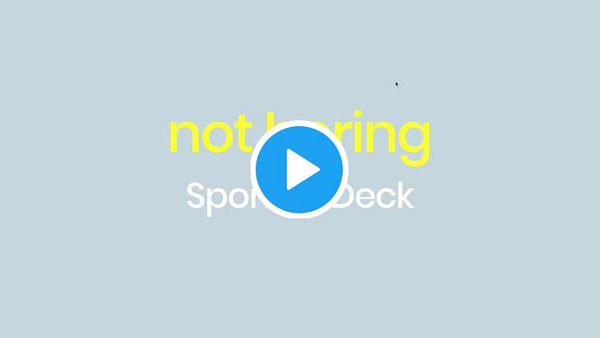
The Twitter thread worked: it brought in all of the sponsors for the rest of 2020, including today’s sponsor, Public, and other Not Boring Sponsors that you know and love. From there, sponsorship has spread, like the newsletter itself, through word of mouth.
Today, Not Boring makes money directly in two ways:
Top of Newsletter Sponsorships. This is the sponsorship format you’re familiar with from newsletters and media everywhere: 150 words and a logo at the top of the newsletter. I charge a little more for Mondays than Thursdays because Mondays tend to go more viral. I picked rates out of thin air in the beginning, and then upped them at Jacob Donnelly’s suggestion. I’ve grown rates in line with audience size ever since.
Sponsored Deep Dives. A couple times a month, I dedicate a Thursday newsletter to a paid deep dive on some of the startups I think are most fascinating or encapsulate an important trend. The companies I’ve written about would make a strong venture portfolio: Ramp, MainStreet, Pipe, Masterworks, Fundrise, AltoIRA, UserLeap, and Secureframe, with some more great companies on the way:
This format was a risk -- sponsored content can be hit or miss, and people generally have mixed feelings about it. It’s particularly challenging for me because I’m so naturally optimistic. When I write a Sponsored Deep Dive, I try to write it in the same way that I’d write a normal Monday post, but since I’m being paid, I get feedback that I need to be even more critical about the company than I normally would. (Read how I choose which companies to write about here).
Generally, though, these Sponsored Deep Dives get more positive feedback than I was expecting, and give people a behind the scenes look at companies that normally don’t share much information publicly. They’re here to stay, and I’m going to be tweaking and evolving these based on feedback in the coming months.
So far, sponsorships have proven to be the right path for Not Boring. After many months of generating no revenue, the business side of Not Boring is starting to pick up steam, and April is set to be the best month yet:
Not Boring is going better than I expected and just hit an inflection point, and I’m incredibly grateful for that. One of the challenges with the newsletter business, though, is that there’s “key man risk.” To a potential buyer or investor, that means that it’s a tough investment, because if I get hit by a bus, the business is dead. That’s even tougher for me and my family: if I get hit by a bus… you get it.
That means that even though this is my own business, I’m still the labor, and we all know that capital makes more money than labor. Fortunately, a happy accident of the decision to stay free is that Not Boring’s increased surface area has opened up new and unexpected opportunities, the most exciting of which is the ability to invest in startups together.
Lesson: When your business model, product, and growth strategy align, magic happens.
The Not Boring Syndicate
Back in June, my friend Fed Novikov reached out. After some time running the Backyard project at Airbnb’s Samara, he and his brother, Petr, were starting their own company, Apt. Fed and I had discussed the Natively Integrated approach before, and the Novikovs were using it to build their business. He asked if I would be up to write about Apt and why the Natively Integrated approach makes sense for real estate development. I was.
We also talked to Jonathan Wasserstrum, who runs a leading AngelList syndicate, and he agreed to syndicate the deal. In July, I wrote the first Not Boring Investment Memo: Apt: The Natively Integrated Developer, and accredited readers were able to invest through Jonathan’s syndicate.
It went well, and Fed suggested that I start a syndicate for Not Boring. I hadn’t thought about doing anything venture-related before he suggested it, but agreed there was a compelling opportunity. On one side, I could help founders explain what they do. On the other, I could demystify startup investing, which seemed like a dark art reserved for a chosen few.
Just writing about companies is one thing, but putting my money where my mouth is, and giving readers the opportunity to do the same, gave me more skin in the game. Plus, I thought that we could give portfolio companies an early advantage by helping them tell their story to potential customers, employees, and investors.
In late July, we launched the Not Boring Syndicate with a memo on Composer. Since then, over 900 Not Boring readers have joined the Syndicate, and together, we’ve invested $1.88 million in fourteen startups:
The things that we hoped would happen -- companies can attract customers, employees, and investors -- are actually happening. Plus, having a big group of investors and a loud microphone behind you can tip the scales in founders’ favor. These tweets from Kaeya, Ben, and Ian, the founders of Swaypay, Composer, and Outfit, are what it’s all about:
As an added bonus, the Syndicate has been a fun way to let readers participate and build relationships without launching a traditional community. Michael Batnick wrote about the experience as an LP in Everyone is an Investor. That made my week.
Until the day we sent the Apt memo, I never imagined that Not Boring would be able to invest in the companies I write about. Even though I worked at a startup, I was still very much an operator and an outsider. As I hope comes across in my writing, I’m consistently blown away by the companies people build. I know how hard it is; I failed when I tried to do it myself.
This is just the beginning of Not Boring as an investor. More to come on that front very soon 👀
Lesson: More people getting involved in startup investing shifts the balance of power to founders, where it should be.
The Not Boring Flywheel
Practically everything good that's happened for Not Boring so far has been a happy accident. For someone who spends so much time writing about strategy, I’ve put surprisingly little thought into the strategy behind Not Boring. It’s just a newsletter.
But over the past few months -- I think mainly because I’m doing something that I genuinely love doing, analyzing companies and telling their stories, so when adjacent opportunities arise, I seize them -- things have started to come together in powerful ways. Not Boring is developing a flywheel.
In early March, Jake Singer wrote a piece on Not Boring called Million Dollar Newsletter in his newsletter, The Flywheel. I didn’t want to do the piece originally because I thought I would come across as an asshole for having an essay written on me (Not Boring and I are one in the same, it’s different than a normal company). But here I am 5,000 words into writing about myself, so we’re past asshole level now, and the Not Boring Flywheel is worth exploring. Jake wrote:
Packy is a better investor because of his writing, and he’s a better writer because of his investing. You can’t make up a better flywheel even if you tried:
I think he nailed it, but I want to give a concrete example of how it works, and how I decide what to do now that it’s spinning.
It starts with writing about tech companies and trends. Writing (or podcasting, TikTokking, YouTubing, etc…) attracts people who are interested in the same things you are, and people are the most important part of all of this. Putting your thoughts out there also repels people who don’t like the way you think -- that helps too, it saves time.
Writing essays led me to reconnect with Fed, which led me to write the Apt memo, which led to the Syndicate.
Investment memos for the Syndicate showed other startups that I could help tell their story, regardless of whether they’re raising. That’s how Sponsored Deep Dives were born.
Working closely with companies on Sponsored Deep Dives has created some of my strongest relationships in tech, led to investment opportunities for the Syndicate, and introductions to more companies to write about and invest in (thanks especially to Nick Abouzeid and Mike Wenner for spreading the word about Not Boring!)
They also pay the bills, and give me access to companies building the future, which means I can do this full-time and informs my Monday essays, which kicks the whole thing off again.
As the flywheel spins, the audience grows, which gives Not Boring access to new ideas, people, and companies and (hopefully) makes Not Boring more useful to readers, partners, and portfolio companies. As I think about what’s next for Not Boring, new things need to feed the Flywheel.
Lesson: Flywheels work, even if they’re accidental.
The Present and Future of Not Boring
I hope I’ve made this clear throughout, but if I haven’t, let me say it again: I find it incredibly fucking wild that so many of you read the words that I write.
I still view this newsletter today as just a bigger version of the little thing it was a year ago with a few friends and random internet people, but I also realize that with more readers comes more responsibility.
That said: I am not a journalist. I’ll never lie and I’ll always tell the truth, but what I said at the top of the first Not Boring Newsletter remains true today:
The only things I’m not optimistic about are cynics and “well, actually…” people. It’s easy to dunk. It’s easy to look smart saying why things aren’t going to work. But those people are not our people.
Not Boring is for the optimists, and for the people trying to make crazy things happen. I’m definitely going to be biased. I’m going to have the backs of the companies in which we invest, and the companies that support Not Boring.
So what’s next for Not Boring? The answer is, just like a year ago, I have no idea. Unlike a year ago, though, I have 365 days of not knowing, growing, and figuring it out under my belt, and I’m ecstatic to see where serendipity leads us over the next 365.
What I do know is that I unapologetically want Not Boring to be a big business. I want to blur the lines between analyzing, experimenting with, investing in, and promoting the companies and products that I can’t stop thinking about. I want to help companies tell their stories.
In the immediate future, there are a few things I’m incredibly excited about. I can’t share details on two of them quite yet, but one involves investing and the other involves experimenting with some of the Web3 tech I’ve written about. Both are expressions of Power to the Person.
Expect more Twitter Spaces: Spaces Cadets with Austin Rief and The Idea Dinner with Mario Gabriele and Acquired’s Ben Gilbert and David Rosenthal. Long $TWTR!
I’ll also probably start building a little infrastructure under Not Boring -- a new website, maybe a part-time employee or two (perhaps an EA?) -- just in case I get hit by a bus.
Mostly, though, I’m just going to keep writing and following this thing wherever it takes me. When I asked for questions that my Twitter followers had about Not Boring, Tom Critchlow, one of the first Not Boring subscribers and a great writer himself, replied with this:
He’s right. This has been an entirely iterative process. There have been big ups, and even the littlest down feels like the end of the world, but I’ve tried to listen to your feedback to move it in the right direction. This only works if we’re all into it. I’ve gone from having one boss to 42,200. Let’s keep iterating and building this together:
THANK YOU
This is just a newsletter, and I probably spilled way too many words on it, but I’m bewildered and grateful to have this opportunity. It wasn’t guaranteed by any stretch of the imagination, and still isn’t, but I wouldn’t even have a chance without:
All of you who give me your time each week
Everyone who’s helped grow Not Boring by sharing essays and saying nice things
Nathan and Dan for bringing together the Type House and giving me the opportunity to meet so many people who I’ve read and loved for a long time
Tommy for kickstarting Not Boring’s growth
Everyone who has written guest posts: Ali, Jeremy, Reuben, Gil, Dan
Everyone who’s collaborated with me on posts: Ben, Dror, Marc, Ryan
Sponsors who let me tell their story
Founders who let the Not Boring Syndicate join their adventure
My mom for being my coach, my sister for telling me when I’m an idiot (and for letting us invest in her company), and my dad for bouncing ideas back and forth and being supportive about me writing a free newsletter after everything he spent on my education.
My in-laws, who let me turn their basement into Not Boring HQ
Finally, there are two people I couldn’t do this without, and for whom I’m incredibly grateful:
My brother Dan for being my thought partner, calling me on my bullshit, and giving up countless weekend and late-night hours to edit nearly every Not Boring essay this year.
My wife Puja for letting me take a big risk on writing this with no income for months and months as I told her “trust me it’s just a math problem, once I hit a certain number of subscribers I’ll be able to make a little money,” even with a baby on the way. Now that Dev is here, I couldn’t ask for a better mom for him. Thanks for putting up with my moaning every week while doing 100x more than I do and making it look easy (and looking good while doing it all).
Thanks for a very Not Boring year :)
Thanks Dan, Puja, and Meg for editing!
How did you like this week’s Not Boring? Your feedback helps me make this great.
Loved | Great | Good | Meh | Bad
Thanks for reading, and see you on Thursday for a special edition.
Packy






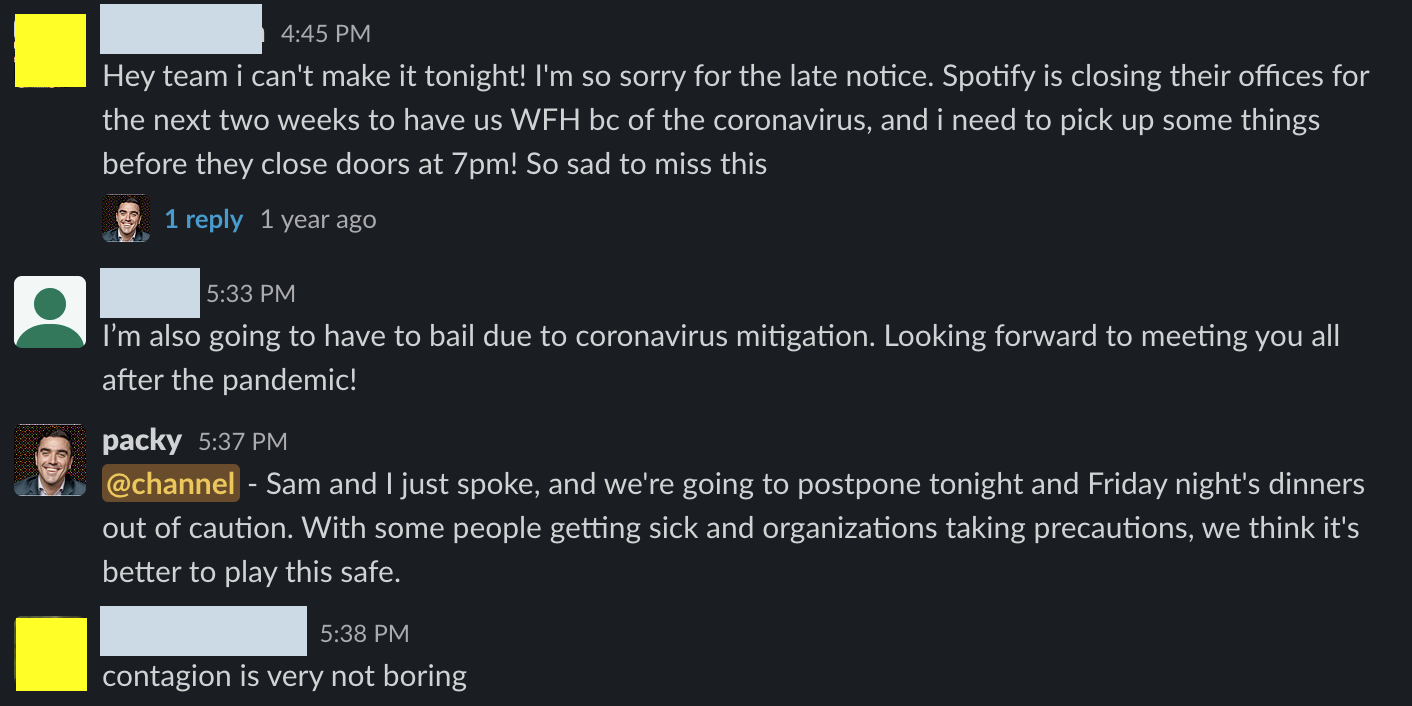
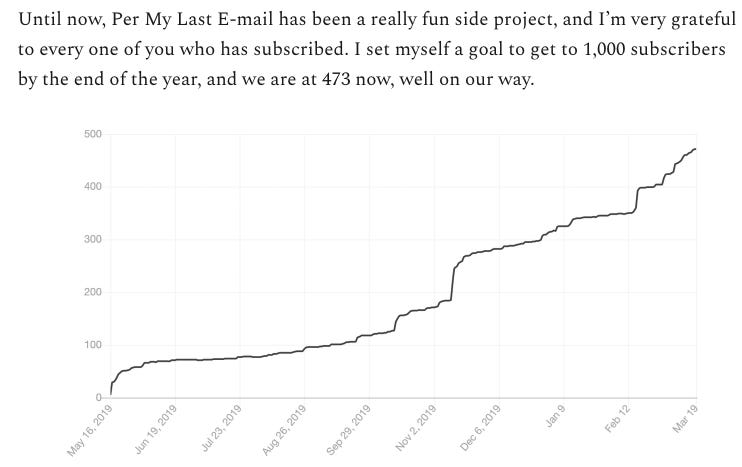







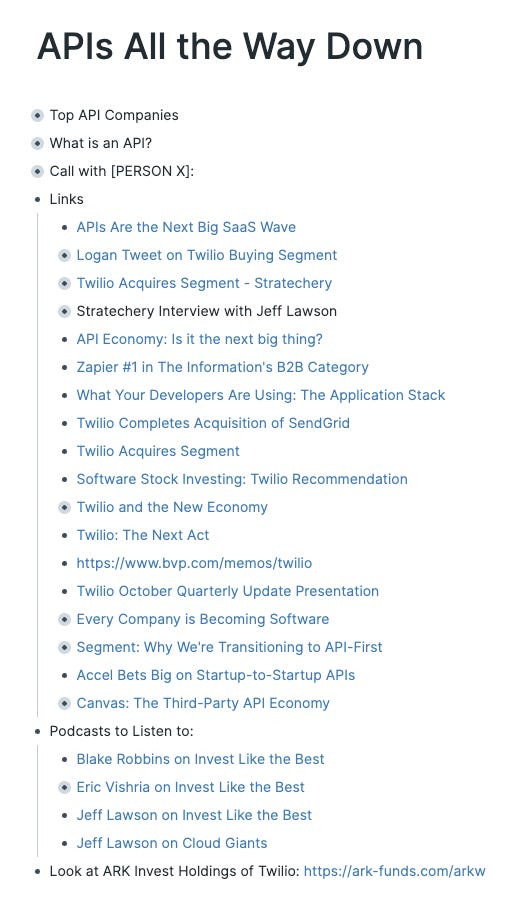
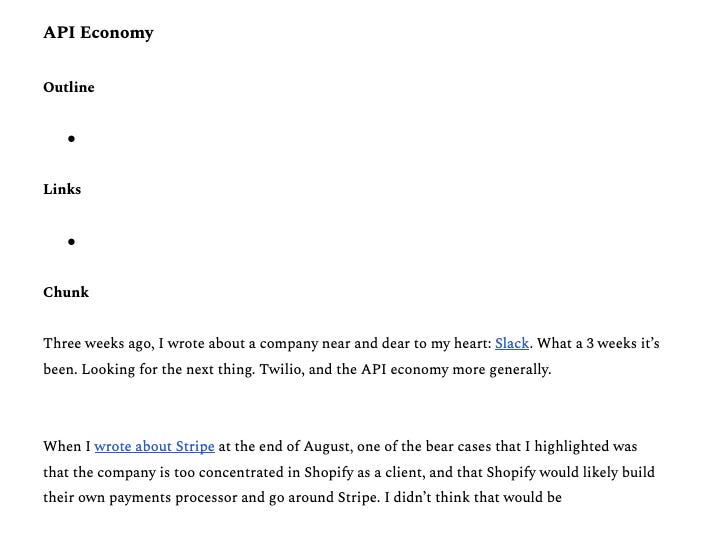
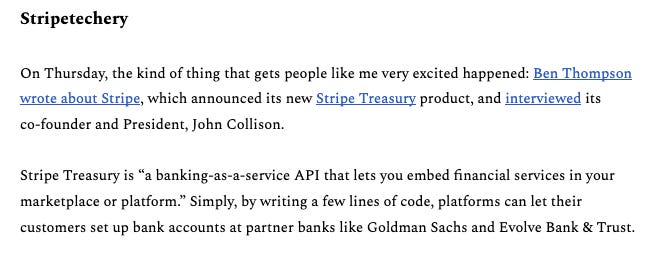

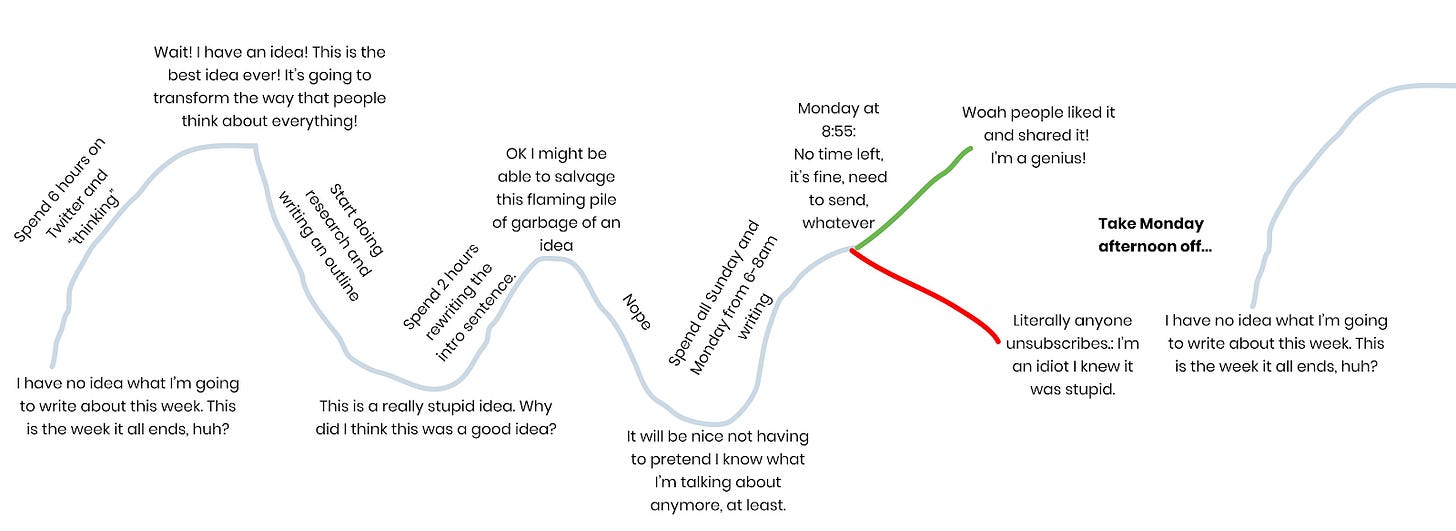


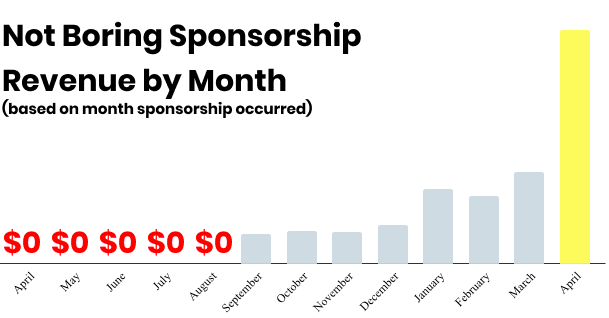



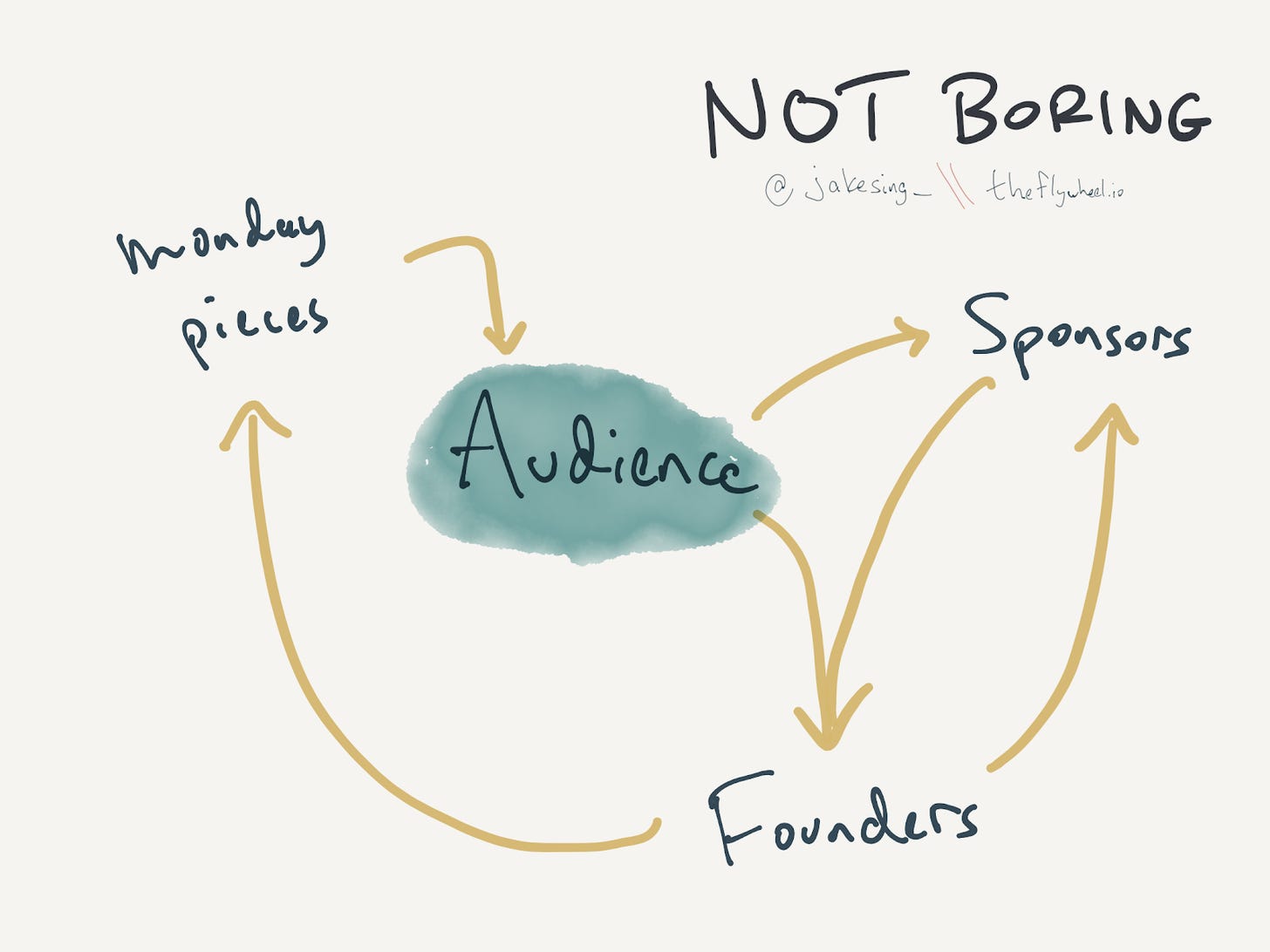






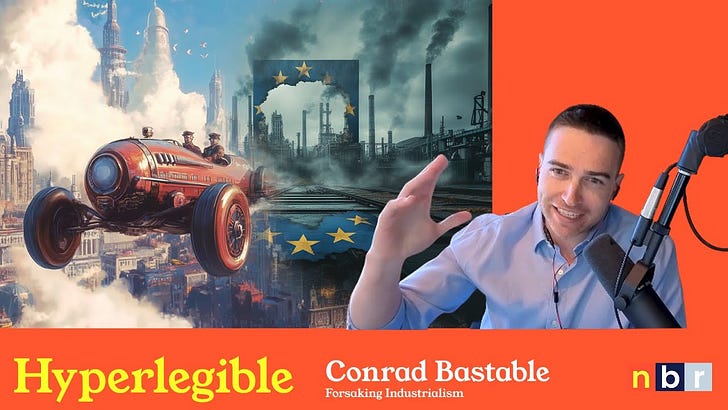


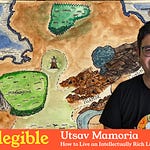
Share this post